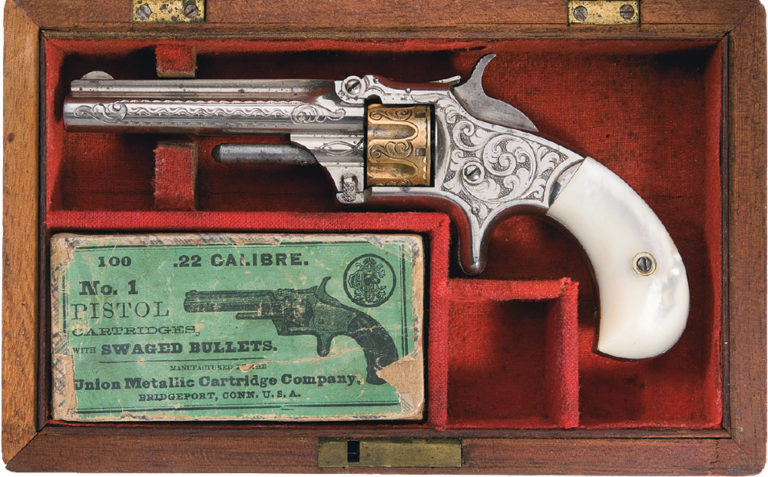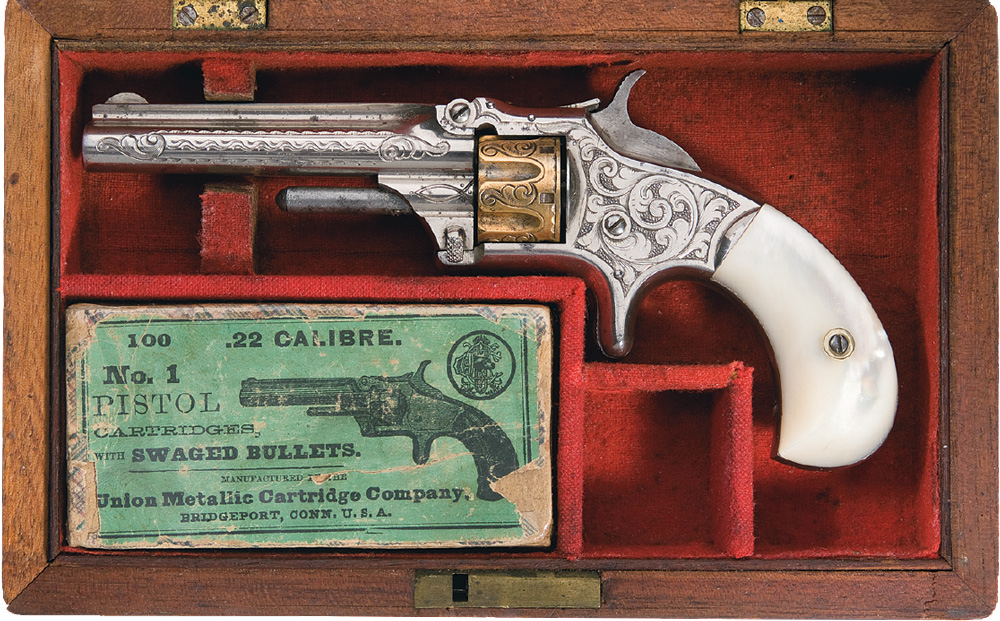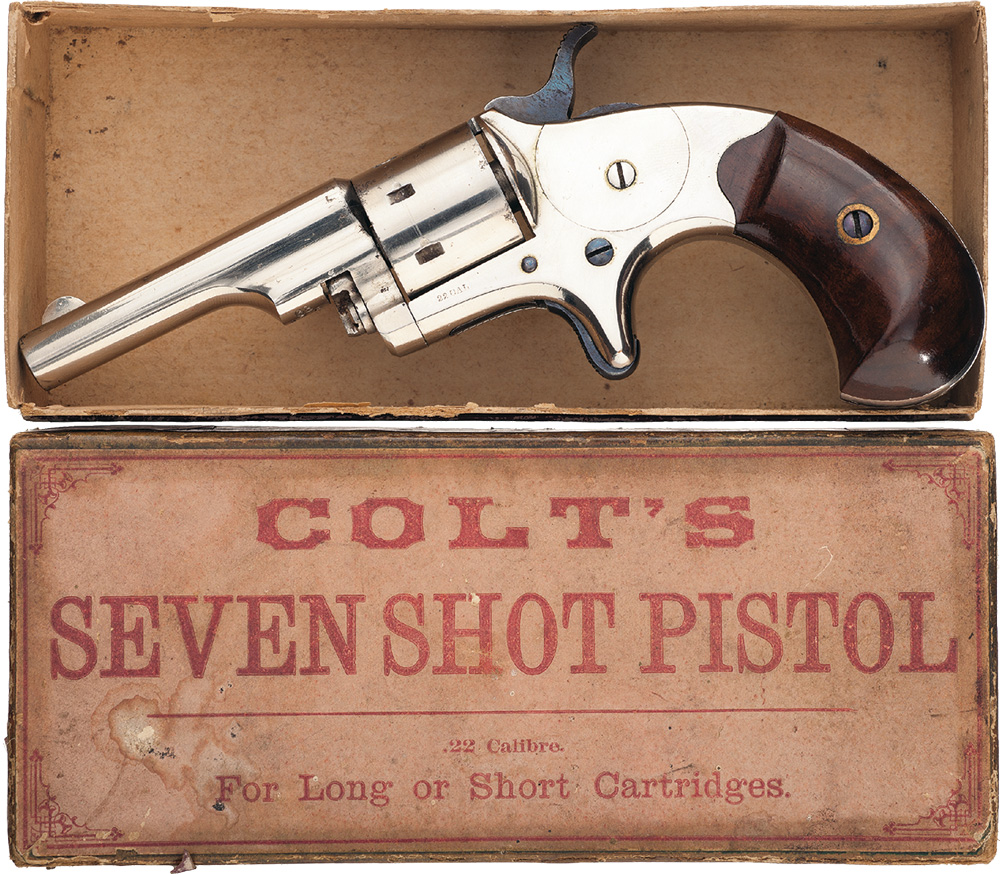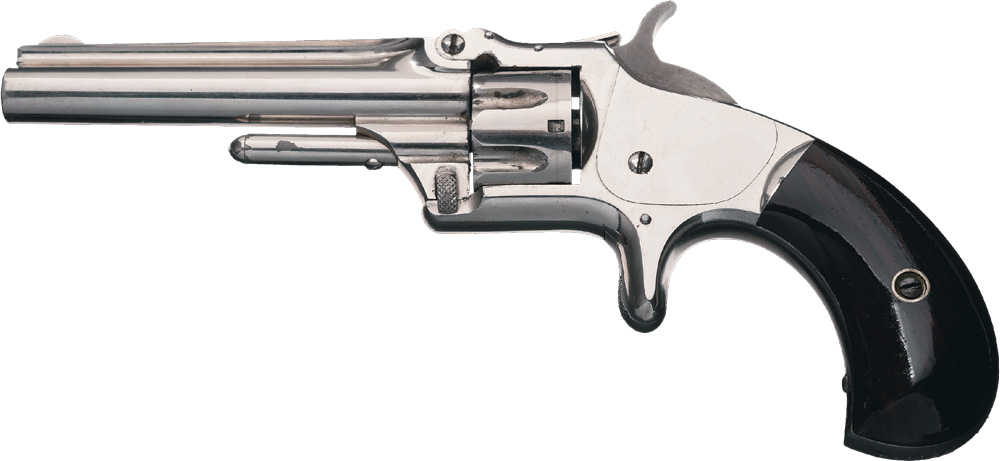

A Colt 1861 Navy revolver at a $700 asking price is a fine gun, and a worthwhile addition to any gun collection. But what does the gun enthusiast who doesn’t have that kind of money to spend on one gun do? Consider the affordable antique .22-caliber revolver.
The percussion purist may laugh, but consider the antique .22-cartridge revolver. In that field, $700 will buy 20 or more guns, these covering the period from the first American cartridge revolver, made in 1857, through the 1890 models that have most of today’s modern revolver features.
The typical .22 antique cartridge revolver is a compact seven-shot arm with a 2- or 3-inch barrel and hardwood, bird’s-head grips. They’ll weigh about 10 ounces, their length a little over 6 inches. Most were made to fire a .22-caliber Short, but not the .22 Short we know now. The smokeless powder of today is too powerful for your antique .22 so don’t ever try it.
The .22-Rimfire History
The story of the small revolvers began in 1854 with the patent of a metallic cartridge by Horace Smith and Daniel B. Wesson. To enable them to manufacture a revolver for this cartridge they had to acquire the patent of Rollin White, a former Colt employee, who held a patent issued April 3, 1855, for a bored-through cylinder to accommodate the breech loading of cartridges.
Rollin White had tried unsuccessfully to sell the rights to Colt. These patents and subsequent improvement patents gave Smith & Wesson (S&W) the sole right to the breech-loading cartridge revolver market for 12 years, until the expiration of those rights in 1869. During this period, S&W produced some 126,000 .22-caliber revolvers in three variations of the model No. 1, plus .32-caliber types as well.
Other makers were not unwilling to try to circumvent these patent rights. White, as part of his contract with S&W, defended the patent vigorously through many court cases. Many well-known names were ordered to cease manufacture, among them Allen & Wheelock, Moore Patent Firearms Co., L. W. Pond Co. and E. A. Prescott. A few companies became licensees, and their revolvers were thereafter marked “Made for Smith & Wesson.” These infringing guns, which usually show a marked resemblance to the S&W original, provide an interesting comparison.
Early S&W .22 revolvers were carried by Civil War soldiers as personal pocket weapons. Their use or effectiveness was minimal but they provided some feeling of protection. Following the Civil War, the little .22 was the traveler’s companion by stagecoach and train. The homeowner and shopkeeper had one in the drawer for protection against itinerants. Despite the publicity given to the two-shot Derringer, ladies of the evening and gamblers often preferred the compact seven-shot revolver. Young boys found them a must for July Fourth celebrations, with blanks of course.
In 1870, the S&W patent expired. Renewal was denied, some say, because President Ulysses S. Grant was still irked about poor Northern ordnance supply during the Civil War. The gates were opened and some 50 manufacturers began turning out .22-caliber revolvers of varying quality. Some were priced as low as $6, and the quality reflected this price. Possibly because the maker didn’t care to share responsibility for malfunction or accident, numerous guns carried only a pet name for identity.
Mail order houses that contracted with a manufacturer sold these for their production. Most often, the mail order firm name did not appear on the gun. Such names on the barrel as Protector, Tramps Terror, Little Giant, ad infinitum, were the only markings.
One manufacturer might produce 25 to 50 variations of the same model with only a name change and a slightly different grip or finish.
Many of these “name-only” revolvers can be traced to a maker, but the process is often difficult. In the more specific area of known manufacturer’s models, the author has compiled a table of some 50 makers, including brief specifications of their early .22 models and the range of their current values to collectors.

Prices and Value
It is worthwhile to remember Oscar Wilde’s definition of a cynic, quoted also by C. E. Chapel in his handbook, as one who “knows the price of everything and the value of nothing.” You may value a revolver in very good condition that fills a void in your collection beyond any book value. Finding such a piece is an exciting discovery and a thrill that cannot be calculated in dollars.
Interest in the small .22-caliber revolver field is increasing, but fortunately prices have not gone upward quite as rapidly as have many others of makes and types.
If you select this area as your specialty, you will find prices range from $20 to $50 for most makes, with such better-known and higher-quality names as Colt, Remington and S&W bringing $75 dollars or more. First models, obviously, are worth more, but few values have gone over $200, at least not so far!

Condition and Cleaning
Be discriminating about the condition of any antique revolver you contemplate buying. There are several “musts.” All parts should be intact and the gun in good working order. While some nicks and age marks are to be expected, 80 percent or more of original finish, with the markings sharp, is required to qualify as excellent. In some cases a patina or thin coating of age over the finish is found. Do not attempt to remove this for you would destroy the character of antiquity.
A sanded or buffed gun, one newly plated or brilliantly brightened, will have lost value, often drastically. Leave ‘em alone!
Your first inclination on acquiring a revolver of 1880 may be to disassemble it. In a word, don’t. The integral parts have operated for almost a century without your probing screwdriver and only harm can result from your efforts.
Oil lightly if you wish, but leave the piece intact. If operation problems occur, try to find an “exploded” or isometric drawing of the model. Then, and only then, should disassembly be attempted—and make sure your screwdrivers really fit. The general rule in the care and repair of antique models is “the less done, the better.”
Before buying that first antique .22, you should know and comply with the gun laws of your particular city and state. In many cases, antique guns (those manufactured prior to 1898) are exempt from regulations applied to modern guns. It is best, however, to have whatever registration is required before doing any buying. Your collection might include a gun made in 1899 or later, or you might be called on to prove date of manufacture of a borderline piece.
With knowledge of values, or at least prices, you are ready to begin your search. Your local gun store may deal primarily in new or current model handguns with a stray antique offered only occasionally. Where then can you look?

When you have acquired several specimens, you will begin to appreciate the reasons that led you to select the antique .22 revolver as your specialty. Although somewhat similar in overall appearance, you will discover interesting variations in the cylinder construction, barrels and cylinder pins, and grips and side plate versus solid-frame construction. Like people, each make has its own characteristics.
Storage of these small, compact guns is relatively easy. A tool chest with two shallow drawers is perfect. Line the drawers with a soft-finished, yet firm cloth, and you’ll have storage for a dozen or so guns. The top area is ideal for tools and parts.
As each succeeding gun is located and added to your collection, your knowledge and mechanical abilities will increase. The pride felt in learning these things is hard to explain, but you’ll find that a new facet has been added to your life activities. In time to come, you may even set down to write pieces like this!
Beyond the true joy of watching your collection and knowledge grow is the health-giving therapy of being totally immersed in your hobby, which often shuts out those everyday problems and worries.
As every collector knows, the peak thrill is the excitement of a rare find, at the right price, that fills a void in your collection. I defy you to match the chill that overcomes you as you spot that rare gun.
You may find it hard to convince your wife that these $30 expenditures at various times are worthwhile. If you do, point out to her that antique guns are always a diminishing quantity through destruction by intention or accident. Demand, however, is always increasing as new collectors join the gun field. More demand, less supply means rising prices in years to come.
A representative collection of these small guns provides a historical picture of the 19th century developments leading to our modern-day cartridge handgun. The world of the antique .22-caliber revolver is a great area for a collection specialty. Come join me!

Next Step: Get your FREE Printable Target Pack
Enhance your shooting precision with our 62 MOA Targets, perfect for rifles and handguns. Crafted in collaboration with Storm Tactical for accuracy and versatility.
Subscribe to the Gun Digest email newsletter and get your downloadable target pack sent straight to your inbox. Stay updated with the latest firearms info in the industry.

![Best Concealed Carry Guns In 2025 [Field Tested] Wilson Combat EDC X9S 1](https://gundigest.com/wp-content/uploads/Wilson-Combat-EDC-X9S-1-324x160.jpg)


![Best 9mm Carbine: Affordable PCCs [Tested] Ruger Carbine Shooting](https://gundigest.com/wp-content/uploads/Ruger-Carbine-Shooting-100x70.jpg)
![Best AR-15: Top Options Available Today [Field Tested] Harrington and Richardson PSA XM177E2 feature](https://gundigest.com/wp-content/uploads/Harrington-and-Richardson-PSA-XM177E2-feature-100x70.jpg)

I need a trigger for a old 22 rifle
I have a tramps terror and would like to try it out. You say today’s 22 cal round is too strong for this gun. Is there a market for 22 shorts that can be used?
My dad is a big fan of pistols and now that he’s retired, he wants to expand his collection of flintlock antiques. I didn’t know that these types of guns actually increase in value as demand for it increases every year. I hope my dad could purchase some nice ones for his collection that he could leave to us as inheritance one day. https://friedlandarms.com/pistols